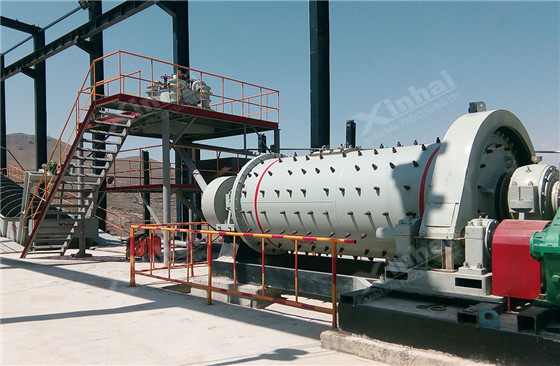
Flotation is a complex processing technology. In flotation systems, there are many types, such as preferential flotation, bulk flotation, partial bulk priority flotation, branch stream flotation, speed flotation, etc. In the flotation systems, there are also flow paths such as one stage flotation, multiple stage flotation, etc. The flow path is the general terms that describe the slurry flowing through the flotation operations. The stage is the number of the combination of grinding and flotation. According to this condition, how to determine the flow path in the flotation systems? In general, it is determined by the embedded features of valuable minerals.
One stage flotation is the flow path which only needs one or two times of grinding in the flotation systems. The ores grind to the floatable grain size and then separate by flotation, which is unnecessary with the second grinding. It is also called the one stage grinding and flotation flow.

The suitable condition is as follows:
(1)The valuable mineral is disseminated extent even, and the grain size is relatively large and not easy clay in the ore.
For example, the heavy metal sulfide ore can separate monomer the valuable minerals when it is ground to 0.3mm. After the coarse grinding, the flotation is used in the one stage grinding flotation system. The qualified concentrate and waste tailings can be obtained.
(2)The valuable minerals are fine disseminated, but not so uniform and not easy to clay.
For this kind of mineral, it can apply the two continuous grinding and flotation in the flotation system. After flotation, it is not necessary to carry out grinding again. This flotation process is also called one stage flotation process. For example, some crystalline mineral needs to be ground under 0.074mm to reach monomer separation. This kind of mineral is fine disseminated even, which is also suitable for one stage flotation process.
Multiple stage flotation is created because most of the ores are disseminated uneven. It needs to carry out grinding after one stage flotation. The flow paths adding grinding after flotation in the flotation systems are called stage flotation. And so on, there is multiple-stage flotation.
The stage flotation is mainly avoiding the over crushing and pelitization of valuable minerals and gangue minerals. It is to discharge the valuable minerals at a rather coarse grain size. Sometimes it is also to separate the coarse concentrates which is monomer separated.
This flow path is suitable for the ores in which valuable mineral complicated disseminated, or the ores which is easy to clay in grinding. The stage flotation can be divided into three circumstances in flotation systems: concentrates regrinding, middling regrinding, and tailings regrinding.

(1)Concentrates regrinding
The condition of concentrates regrinding is that there are 2 or more than 2 kinds of valuable minerals . And they exist as mineral epiphytes. The disseminated grain size of each valuable mineral is fine while their mineral epiphytes is coarse. Under this condition, the concentrates regrinding can be used in the flotation systems.
The first grinding is usually coarse grinding, which separates the aggregation of valuable minerals and gangue minerals. Than flotation carries out to get the mixed concentrate and the tailings.

(2)Middling regrinding
The valuable minerals are under uneven disseminated grain sizes, and the value is also inhomogeneous distribution in the ore. It can apply the middling grinding in the flotation systems.
If the useful minerals are not evenly disseminated in the ore, and the distribution of useful minerals in ore is not uniform (In some part, the valuable minerals are concentrated, while there is none valuable minerals in some part). Under this condition, the first grinding is to dissociate coarse grains from valuable minerals, and also separate some gangue grains without valuable minerals as tailings. Some mineral epiphytes of fine valuable minerals and gangue minerals. After the first stage flotation, some coarse concentrates grains are recovered and tailings are abandoned. The mineral epiphytes are into the middlings. This part of middlings should be reground for the next flotation in the flotation systems to float the fine valuable minerals.

(3)Tailings regrinding
The valuable minerals are uneven inlay of coarse and fine grain, while it is even inlaid in tailings. Or there are valuable minerals in tailings. Under these conditions, the tailings regrinding can be applied in the flotation systems.
The coarse grains are almost dissociated in the first stage grinding. After flotation, part of concentrates are separated. And the tailings with fine valuable minerals regrind and refloat to separate fine valuable minerals. As for the ores easy to clay, this process flow is also suitable.

The above is several common flotation flows in the flotation systems. The reasonable flotation flow is the main factor of requiring a good processing index and reduces the production cost. When choosing flotation flow, this content can be referenced. However, the mine processing experiment should be carried out in production to ensure the mineral composition and ore properties. And the suitable and reasonable flotation flow can be determined according to the analysis results.
To find out more about our products and solutions, please fill out the form below and one of our experts will get back to you shortly.